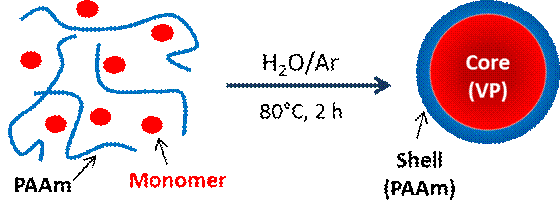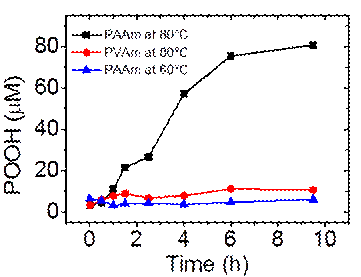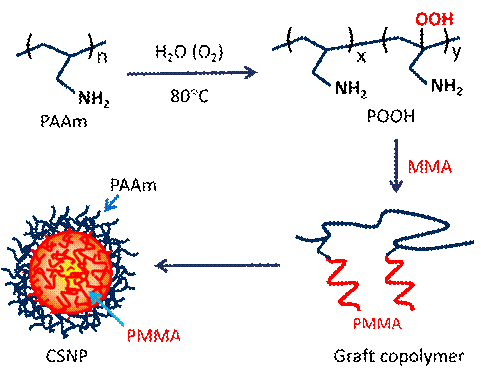58th Annual Report on Research 2013 Under Sponsorship of the ACS Petroleum Research Fund
Reports: DNI750942-DNI7: Solvent-Assisted Coalescent Assembly of Amphiphilic Core-Shell Nanoparticles
Junmin Zhu, PhD, Case Western Reserve University
The assembly of nanoparticles is a key step for the development of advanced nanodevices with various structural designs for fundamental interface studies, industrial and biomedical applications. However, the major impediments to progress in the development of advanced nanomaterials are the lack of versatile nanoparticles as building blocks, undefined control of assembly processes, and limited potential for scale-up production. To address these challenges, the proposed research seeks to develop a novel strategy, solvent-assisted coalescent assembly of core-shell nanoparticles (CSNPs) into advanced nanostructures. Hydroperoxide-amine initiated graft polymerization (HAIGP) provides a facile way to prepare well-defined amphiphilic CSNPs with hydrophilic amine-containing polymers (HAPs) like branched polyethylenimine (PEI) as the shell and hydrophobic vinyl polymers like poly(methyl methacrylate) as the core. To improve this process, we have developed an efficient polymerization approach, pseudo initiator-free graft polymerization (PIFGP) to prepare cationic core-shell nanoparticles (CSNPs) with poly(allyl amine) (PAAm) as the shell (Figure 1). In the typical PIFGP process, there are no initiators added in the polymerization system, which means the process is “initiator-free”. However, during the reaction, PAAm-based redox macroinitiators are formed due to the formation of PAAm-based hydroperoxides, and subsequently induce the graft polymerization of vinyl monomers from PAAm. Thus, we designate this type of graft polymerization as “pseudo initiator-free graft polymerization” (PIFGP). These unique CSNPs have hydrophobic homopolymers in the core, which can be extracted to form hollow nanoparticles or assembled by coalescence into nanaofibers or nanotubes. Over the second year of the project, our work has focused on the preparation and characterization of PMMA@PAAm CSNPs by PIFGP for solvent-assisted coalescent assembly.
Fig 1. Process of PIFGP to fabricate PMMA@PAAm CSNPs
Synthesis of PMMA@PAAm CSNPs by PIFGP. Typically, there were only two major components in a PIFGP system (Figure 1), including PAAm (Mw 65,000) and vinyl monomers, such as methyl methacrylate (MMA) or N-isopropylacrylamide (NIPAm). The reaction was carried out under continuous argon (Ar) purging and magnetic stirring at 500 rpm at 80°C for 2 h. Even without addition of initiators in this emulsion polymerization system, stable latex nanoparticles were formed with vinyl polymers (VPs) as the core and PAAm as the shell (designated as VP@PAAm CSNPs). In this research, MMA was used to form a hydrophobic core of poly(methyl methacrylate) (PMMA).
PAAm has a tertiary carbon-hydrogen (C-H) bond on each repeating unit. The tertiary carbon structure has a lower C-H bond dissociation energy, compared with corresponding primary and secondary structures, and the order of stability of carbon radicals is: tertiary > secondary > primary > methyl. Thus, compared with poly(vinyl amine) (PVAm), PAAm should be easier to form polymer hydroperoxide (POOH) due to the lower bond dissociation energy of the tertiary C-H bonds. To confirm this, we measured the POOH formation of PAAm and PVAm in water with purging Ar under the similar reaction conditions for CSNP preparation.
Fig 2. Formation of polymer hydroperoxides (POOH) with PAAm and PVAm in aqueous solutions.
There are both hydroperoxide (-OOH) and amino (-NH2) groups on PAAm-based POOH, which can act as redox macroinitiators. Since there are abundant amino groups on PAAm, the formed -OOH groups on PAAm can interact with –NH2 groups to form intra- or intermolecular redox pairs to initiate the graft copolymerization of vinyl monomers. The mechanism for CSNP formation by PIFGP include three major steps (Figure 3), including: (i) PAAm reacts with oxygen to form POOH; (ii) POOH acts as redox macroinitiators to initiate the graft polymerization of MMA; (iii) The growing graft copolymers of PAAm-g-PMMA are self-assembled in situ into CSNPs with VPs as the core and PAAm as the shell.
Fig 3. Proposed mechanism of PIFGP to synthesize PMMA@PAAm CSNPs with PMMA as the core and PAAm as the shell.
Morphology and coalescent assembly. Morphological analysis by SEM and TEM shows PMMA@PAAm CSNPs had a narrow size distribution with an average diameter of 110 nm (Figure 4A), and possess a well-defined core-shell structure with a shell thickness of 7 nm and a core diameter of 100 nm (Figure 4B). PMMA@PAAm CSNPs have an unique structure feature with homopolymer PMMA in the core, which can be dissolved and extracted by organic solvents to form hollow structures. Our previous results show that the addition of organic solvents into latex PMMA@PEI CSNPs by HAIGP (Fig 4C) was able to overcome the core/shell interfacial energy barrier to induce the interparticle interactions under shear flow, while controlling of the solvent solubility and water miscibility assisted the coalescent assembly of CSNPs into advanced nanostructures, such as nanofibers (Fig 4D). Chloroform was used for solvent-assisted coalescent assembly of CSNPs by an extraction and evaporation method. The PMMA@PAAm CSNPs by PIFGP will be used for coalescent assembly by this similar method.
Fig 4. (A) SEM micrograph of PMMA@PAAm CSNPs by PIFGP. (D) TEM micrograph of PMMA@PAAm CSNPs by PIFGP. (C) SEM images of PMMA@PEI CSNPs by HAIGP. (D) Chloroform-assisted assembly of PMMA@PEI CSNPs by HAIGP.
Impact of the research. The support of this ACS PRF grant has enabled the PI to develop PIFGP as an efficient strategy to prepare CSNPs without adding any initiators, establish a versatile coalescence method for assembling CSNPs into advanced nanostructures, and collect key results for attending one national meeting and preparing two manuscripts. In addition, there are postdoc and graduate and undergraduate researchers supported by this award, and they have learned valuable skills in the synthesis and characterization of polymers and nanomaterials, graft emulsion polymerization, and molecular self-assembly.
Copyright © 2014 American Chemical Society















